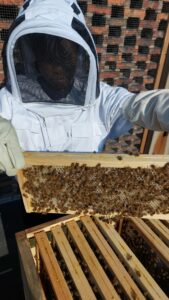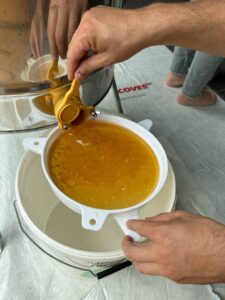The Dansaert Center has been hosting beehives on its rooftops for several years. This initiative, carried out in collaboration with Christophe Lootvoet – Atelier d’Architecture et d’Ingénierie ALTER – housed here, aims to combat the erosion of biodiversity, especially that of pollinating insects.
What is the interest in preserving bees?
Pollinating insects play a crucial role in the reproduction of nearly 4/5 of our wild flora and agricultural crops, contributing 15 billion euros to the European scale. This ensures a fundamental function for the maintenance of ecosystems and the services they provide.
With 40% of estimated insect species threatened with extinction globally, the decline of pollinators directly threat

ens biodiversity, food (both quantity and quality of crops), and human societies, including public health.
In addition to this issue, beekeeping allows for occasional honey supply.
Where are the bees ?
A colony is hosted on the building’s rooftops, at the level of wing A. A permit is required for about three colonies, but for the Center’s colony, an Afsca declaration has been made.
As soon as temperatures exceed 10 degrees (March), bees leave the hive to start their season, which lasts until autumn. The Center’s bees produce about 30kg of honey per year. In July, preparations for the following winter begin.
source: C. Lootvoet
What safety measures are taken?
Regarding the colony’s health, it is treated every winter against varroa (a mite parasite of bees). The treatment is carried out using essential oils. Bees are also regularly monitored for foulbrood disease.
Regarding the surrounding neighborhood, there is specific legislation regulating beekeeping in Brussels. Its purpose is to protect both bees and residents. Therefore, a distance of 20 meters between the apiary and a residence or public road must be respected. This distance is reduced to 10 meters if a solid obstacle of at least 2 meters in height is between the apiary and the residence or public road. This allows us to host the bees.
If you wish to install beehives at your place, you can inquire with your municipal administration to know the regulations in detail.
Which beespecie is housed?
The Buckfast bee is a hybrid bee increasingly used by beekeepers. It is a crossbreed of honeybees. The Center’s bees are called F1, meaning the queen has genes only from bees of this species.
Qualities:
- Character: The Buckfast is known for its gentle behavior at all times and in all places.
- Foraging: The bees are excellent foragers, facilitated by the length of their tongue, allowing them to forage various flowers, even those with deep corollas.

- Production: This hybrid bee produces very interesting harvests because it is reputed to be very industrious.
- Resistance: This bee is very resistant, especially to cold climates and certain diseases (compared to the black bee).
- Honey conservation: The Buckfast bee preserves its honey well and takes care to keep it away from the brood tonot hinder egg-laying.
Points of attention
- Asian hornet: Adjustments to the hive help fight against hornet predation.
- Diseases: Along with the hornet, diseases are the main cause of bee mortality.
source: C. Lootvoet
- Provision problem: To hibernate well, the bee needs a large quantity of provisions. Indeed, it tends to consume a lot of food, requiring the beekeeper to regularly monitor reserves throughout the winter period. This attention is even more pronounced when winter is long or the climate is very cold.








